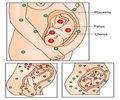According to a review intermittent preventive therapy for malaria was associated with a higher birth weight and lower risk of low birth weight than the current standard 2-dose regimen.

Kassoum Kayentao, M.D., of the Liverpool School of Tropical Medicine, Liverpool, United Kingdom, and colleagues conducted a review and meta-analysis to evaluate whether 3 or more doses of intermittent preventive therapy during pregnancy with sulfadoxine-pyrimethamine are associated with higher birth weight or a lower risk of low birth weight (LBW; less than 5.5 lbs.) than a 2-dose regimen. After a review of the medical literature, the researchers identified 7 trials that met inclusion criteria. These trials included 6,281 pregnancies.
Analysis of the data indicated that women in the ≥ 3-dose group had a 20 percent lower risk of having a LBW infant. The absolute risk reduction was 33 per 1,000 women, from a median (midpoint) risk of 167 per 1,000 in the 2-dose group to 134 per 1,000 in the ≥ 3-dose recipients (number needed to treat = 31). The median birth weight in the 2-dose group was 6.3 lbs., and on average 2 ounces higher in the ≥ 3-dose group.
"The association was consistent across a wide range of sulfadoxine-pyrimethamine resistance. There was no evidence of small-study bias. The ≥ 3-dose group had less placental malaria," the authors write. "There were no differences in rates of serious adverse events."
"These data provide support for the new World Health Organization (WHO) recommendation that intermittent preventive therapy during pregnancy with sulfadoxine-pyrimethamine be provided at each scheduled focused antenatal-care [before birth] visit in the second and third trimesters in all settings in which intermittent preventive therapy during pregnancy with sulfadoxine-pyrimethamine is recommended. Future research should focus on how best to implement the updated WHO guidelines for intermittent preventive therapy during pregnancy with sulfadoxine-pyrimethamine and specifically their integration with focused antenatal care. Continued monitoring of the association between population-level sulfadoxine-pyrimethamine resistance and the effectiveness of intermittent preventive therapy during pregnancy is required," the researchers conclude.
Source-Newswise















